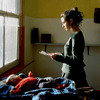Review: The Way Home by Tom Hunter

“In this book,” writes Tom Hunter in the introduction to The Way Home, “I have set out many of the bodies of work I have created over the last twenty-five years while making my journey through the streets of Hackney, trying to make sense of this urban maze and find my way home.” And: “While my subject has always been Hackney, the influences behind my art practice are found in the work of Johannes Vermeer, the Pre-Raphaelites and, latterly, a whole raft of art historical paintings.” These words set the scene for the photographs in the book, an impressive range of work.
I would be tempted to point out more references than the classics - some of the wide-angle interiors reminded me of Chauncey Hare - but it is the classics, of course, which pull in one’s attention, especially those so well known. Hunter’s 1998 Woman Reading a Possession Order references Vermeer’s 1657 Girl Reading a Letter at an Open Window, but there are some crucial differences. Starting with the title, Vermeer is not committing to anything, it’s a letter. In contrast, Hunter has the woman (not girl) read a possession order. Vermeer literally pulls aside a curtain to allow us a glimpse of the private scene. Hunter’s camera does not need to play this kind of game any longer. And crucially, in the foreground Vermeer’s still life is replaced with a baby lying on a simple blanket, a baby basked in the strong light flowing in through the window. Hunter thus does not necessarily re-create the older piece of art. Instead, he produces a contemporary variant that not only takes into account the differences in the media, but that also takes a stance: The beautiful photograph shows a young mother learning she is going to be evicted from her home.
Mind you, not all of Hunter’s work plays out these kinds of scenarios. There are landscapes as well, plus photographs of interiors, an occasionally bewildering variety of work. But everything is firmly held together by the artist’s vision, the main impetus being the following: “let’s try to lift the people in our art, whatever the art form, and however the people.”
I’m sure there will be lots of people who will be uncomfortable with this aspiration - especially given the state of the art world, in which many artists (including, sadly, many young artists freshly graduating from MFA programs) have now fully embraced their role as the court jesters of the plutocrats, to be fed morsels off their tables. Does it really have to be that way? It’s hard to say whether another art world is possible - where and how to banish the Gagosians and Hirsts? But it might be worthwhile to at least entertain that idea, “to lift the people in our art” - and not just the select few.
The Way Home, photographs by Tom Hunter, essays by Geoff Dyer, Tom Hunter, and Michael Rosen, 200 pages, Hatje-Cantz, 2012

